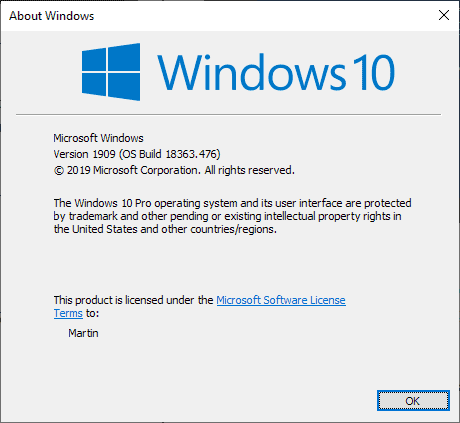by Martin Brinkmann on November 24, 2019 in Windows –
6 comments
Microsoft released the November 2019 Update for the company’s Windows 10 operating system on November 12, 2019. The update is available to “seekers”, administrators who run manual checks for updates on devices running Windows 10 or who use the Update Assistant or other tools to download and install the new feature update.
Windows 10 version 1909, the November 2019 Update, is special as it is the first feature update that has not been released like all other feature updates that came before it.
The core difference is that the update is turned on using what Microsoft calls an enablement package; this package is merely a switch that activates the new version as all of its files were already planted on systems that run the May 2019 Update for Windows 10.

Since the new version is turned on with a simple update, the process of upgrading to the new version is faster and less error-prone than before. One downside to the process is that there are not many changes when compared to the May 2019 Update.
It was not clear up until recently whether future Windows 10 feature update releases would follow the upgrades released in 2019 — meaning one major feature update and one minor, faster update — or if Microsoft would restore the old two major feature updates per year process.
During a discussion on Mixer, Microsoft revealed that it has no plans to use enablement packages in the future. While that does not mean that the company won’t be using these in the future, it appears that the company will return to the two feature updates per year schedule of earlier years.
One of the questions presented during the presentation and the answer that Microsoft gave was the following one:
Q: Will we see this cycle for every year? Major feature update in H1, more minor feature update in H2, one cumulative update for both?
A: Delivering the 19H2 feature update via cumulative update and an enablement package is a pilot program. There isn’t a formal plan in place to deliver future releases in the same way. We are closely monitoring feedback and hoping to learn from this type of release to help influence our future plans
There you have it; Microsoft confirms that it may use the new process in the future but that it does not have plans to do so in 2020.
Closing Words
I still think that two feature updates per year are too many. First, because it adds a lot of stress to administrators who have to deal with these updates — which take longer than regular cumulative updates and are more error-prone — and second, because these don’t add too many new features to the operating system either that would warrant a major new release.
Now You: What is your take on this? Is two major feature updates one to many? (via Windows Latest)